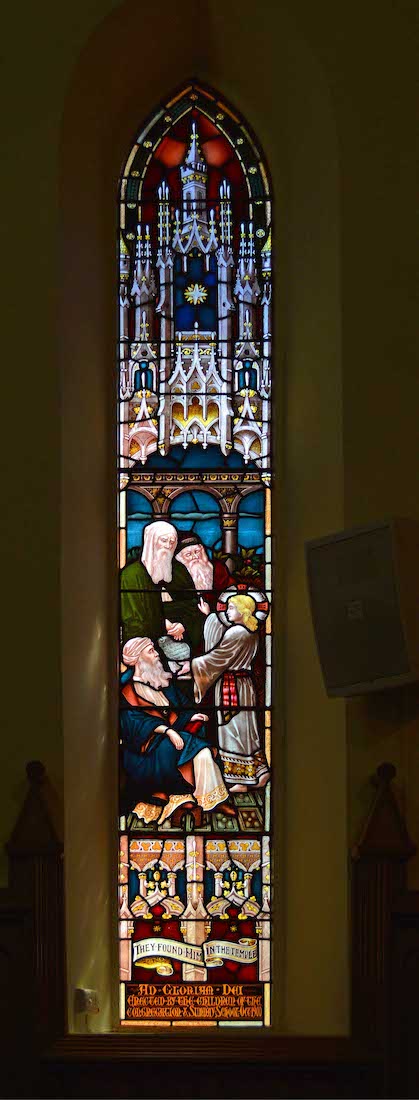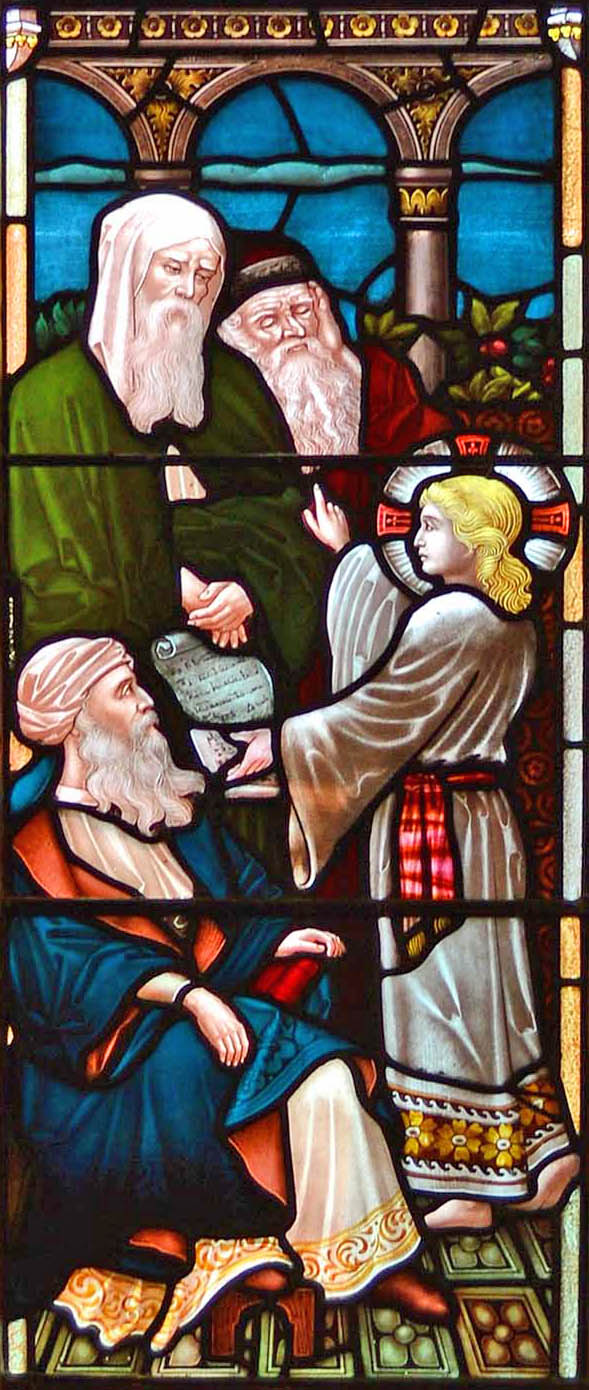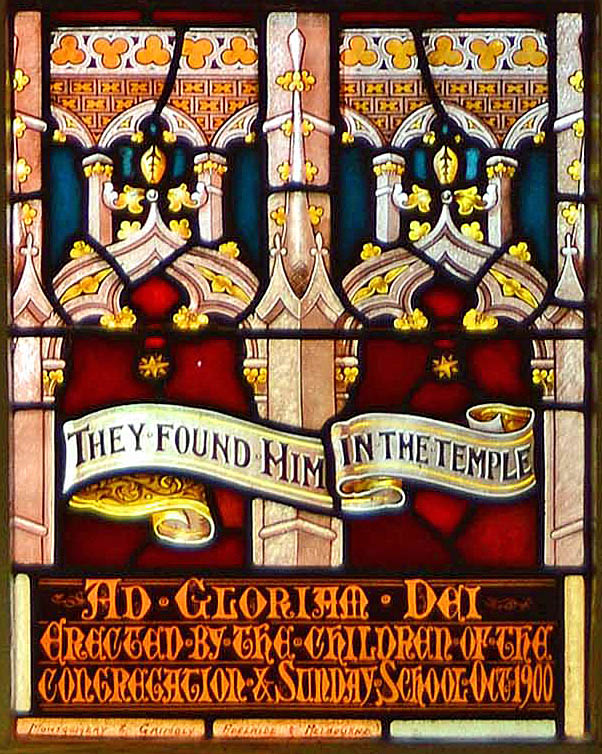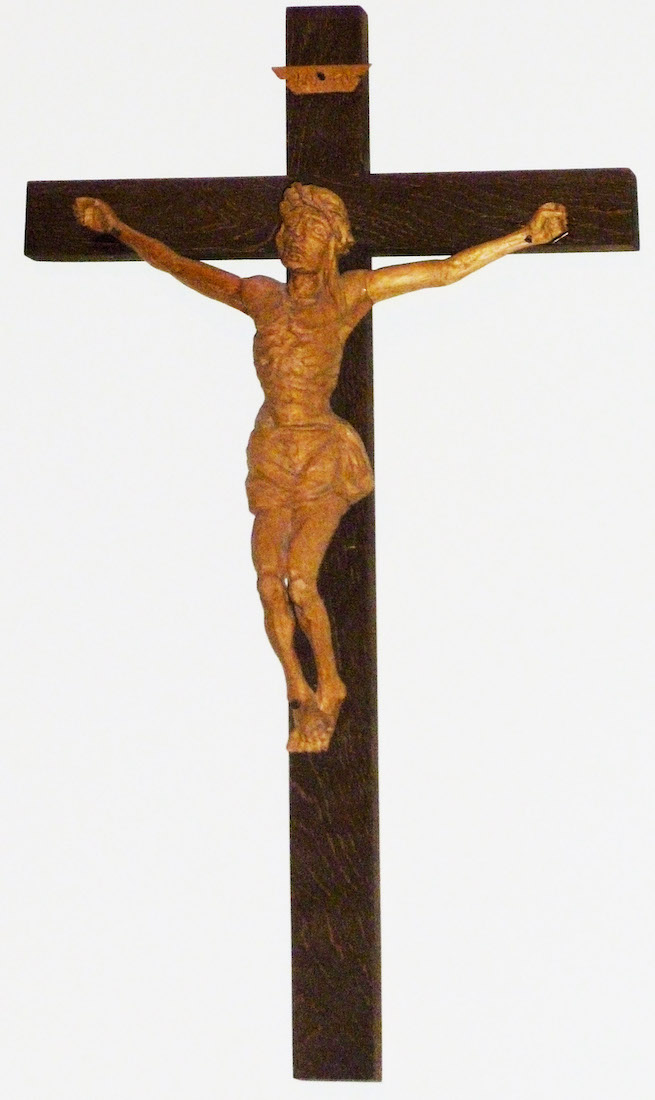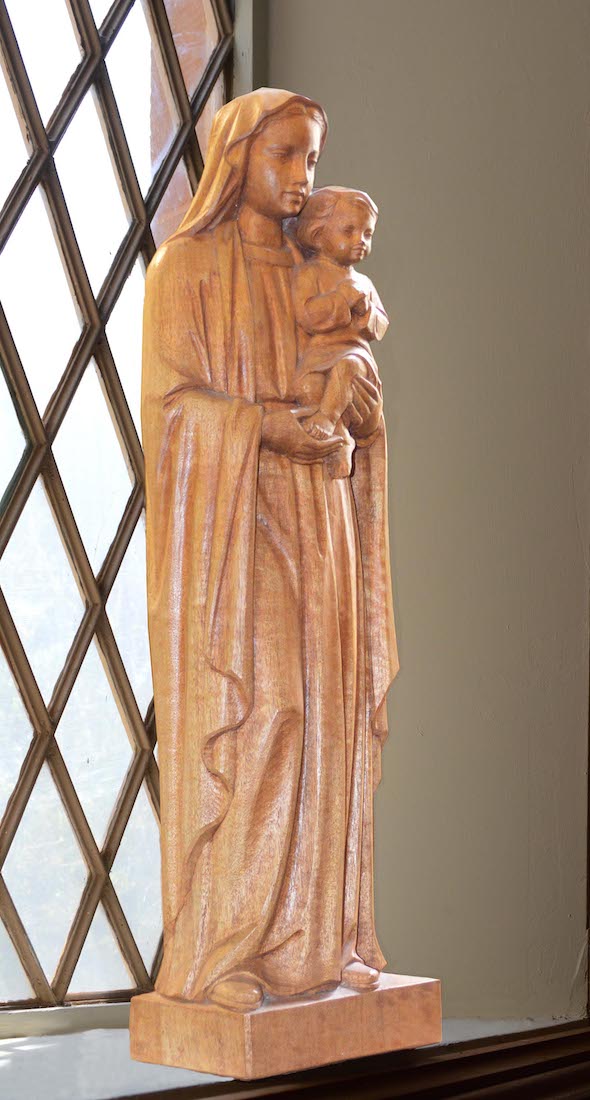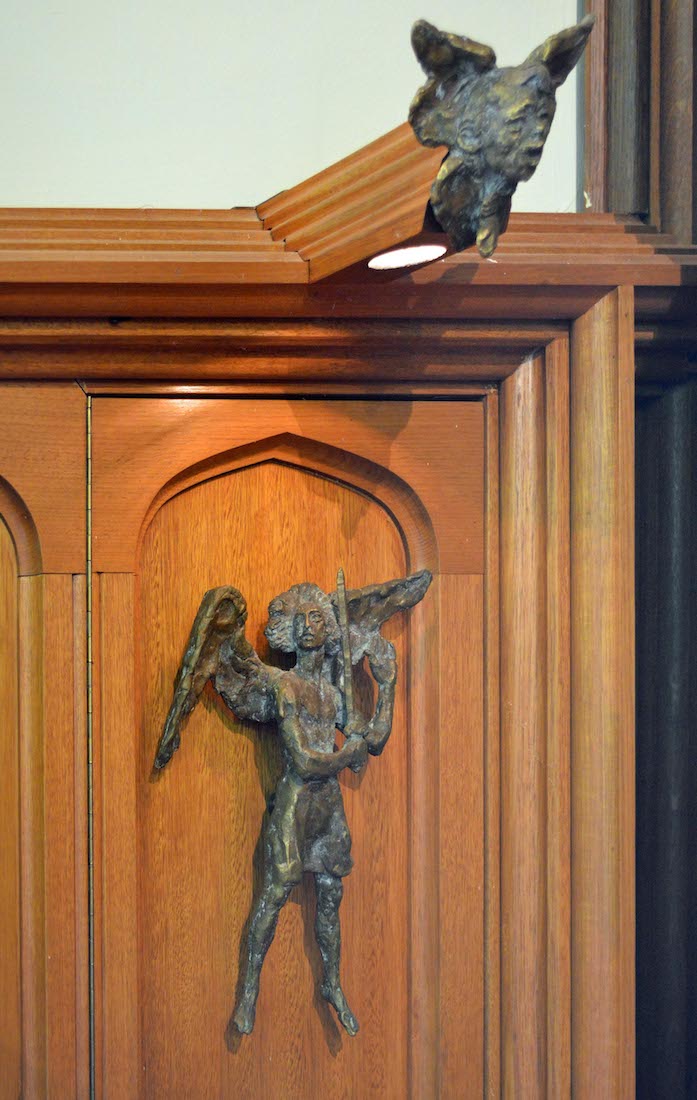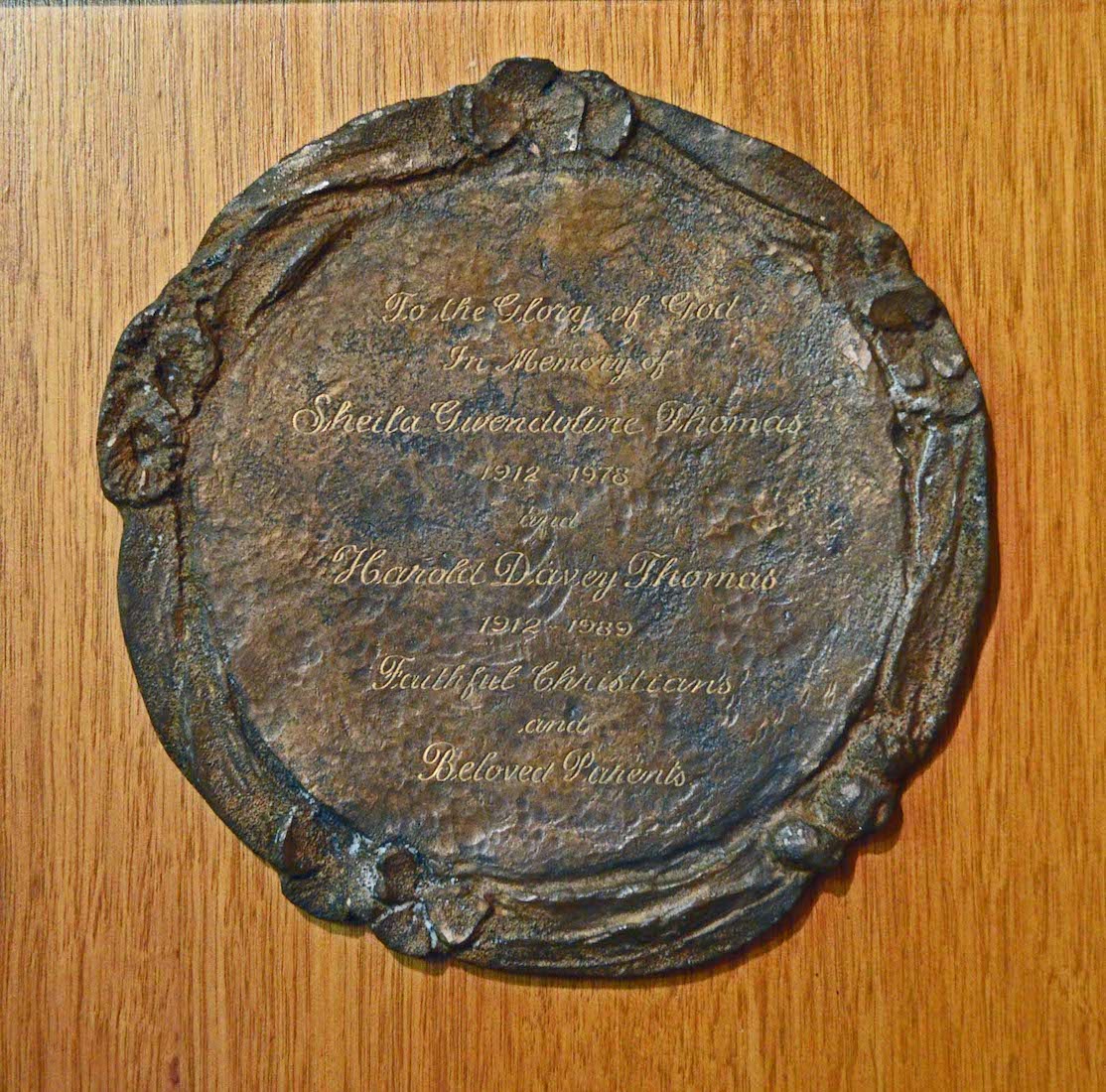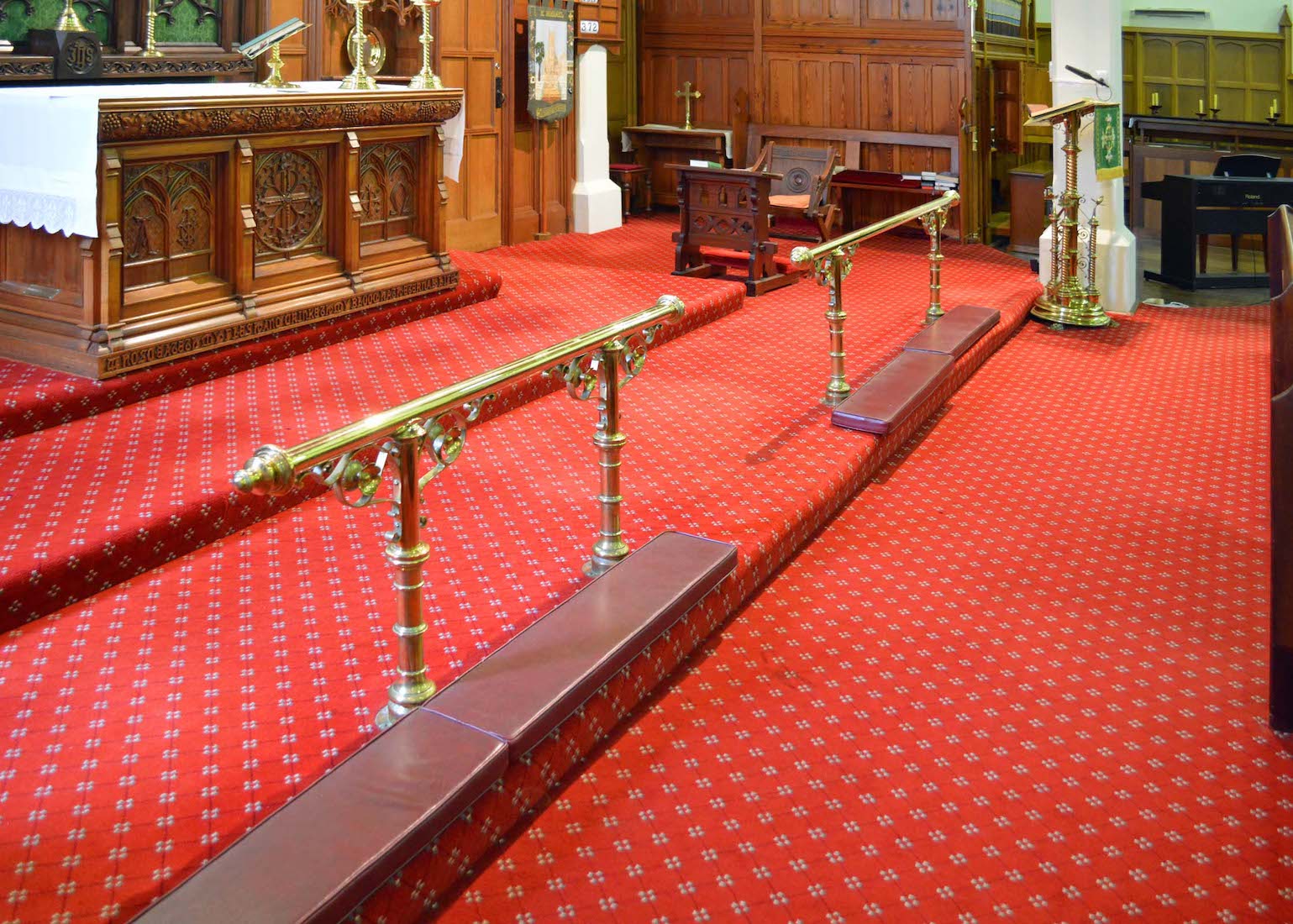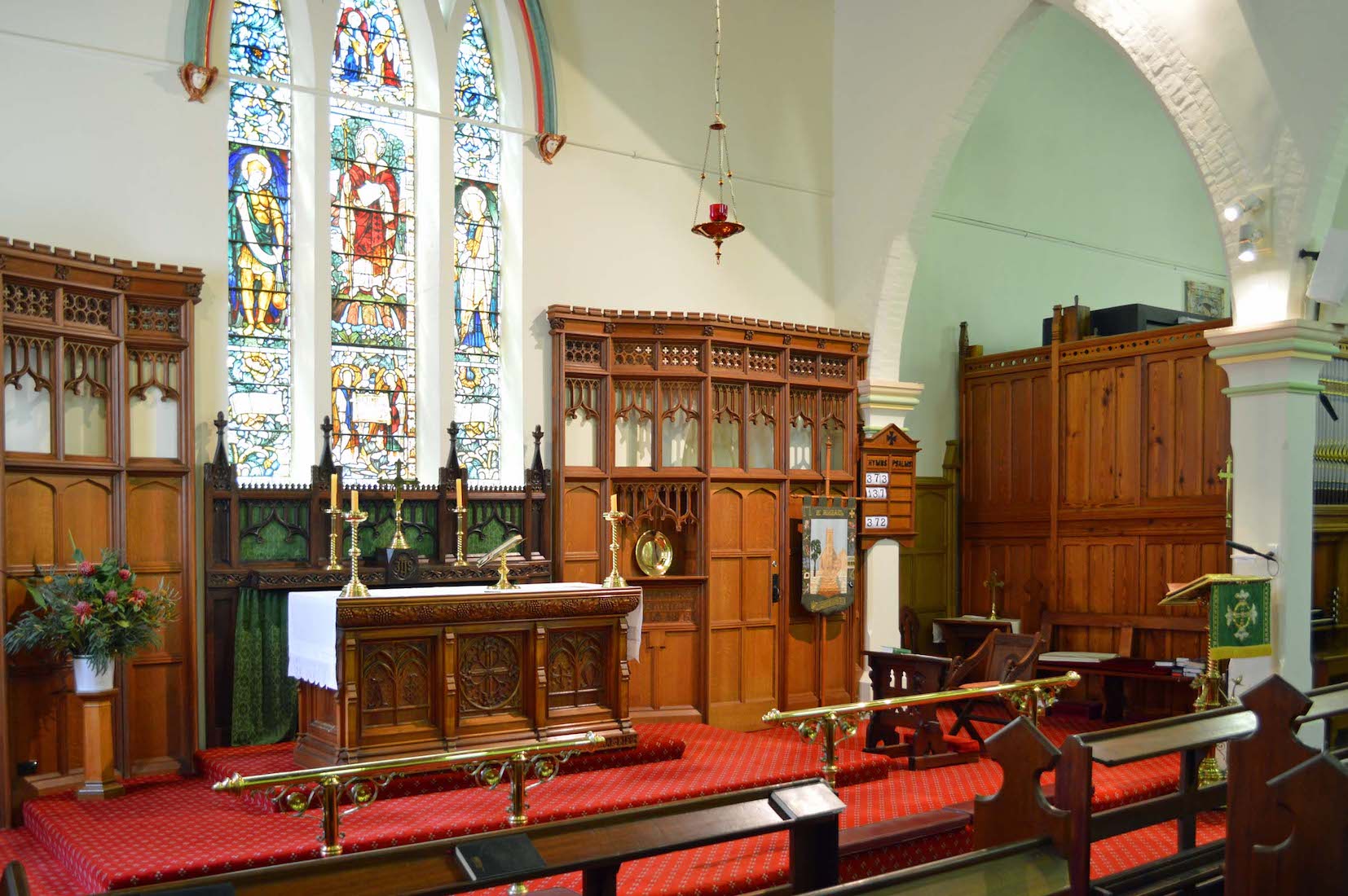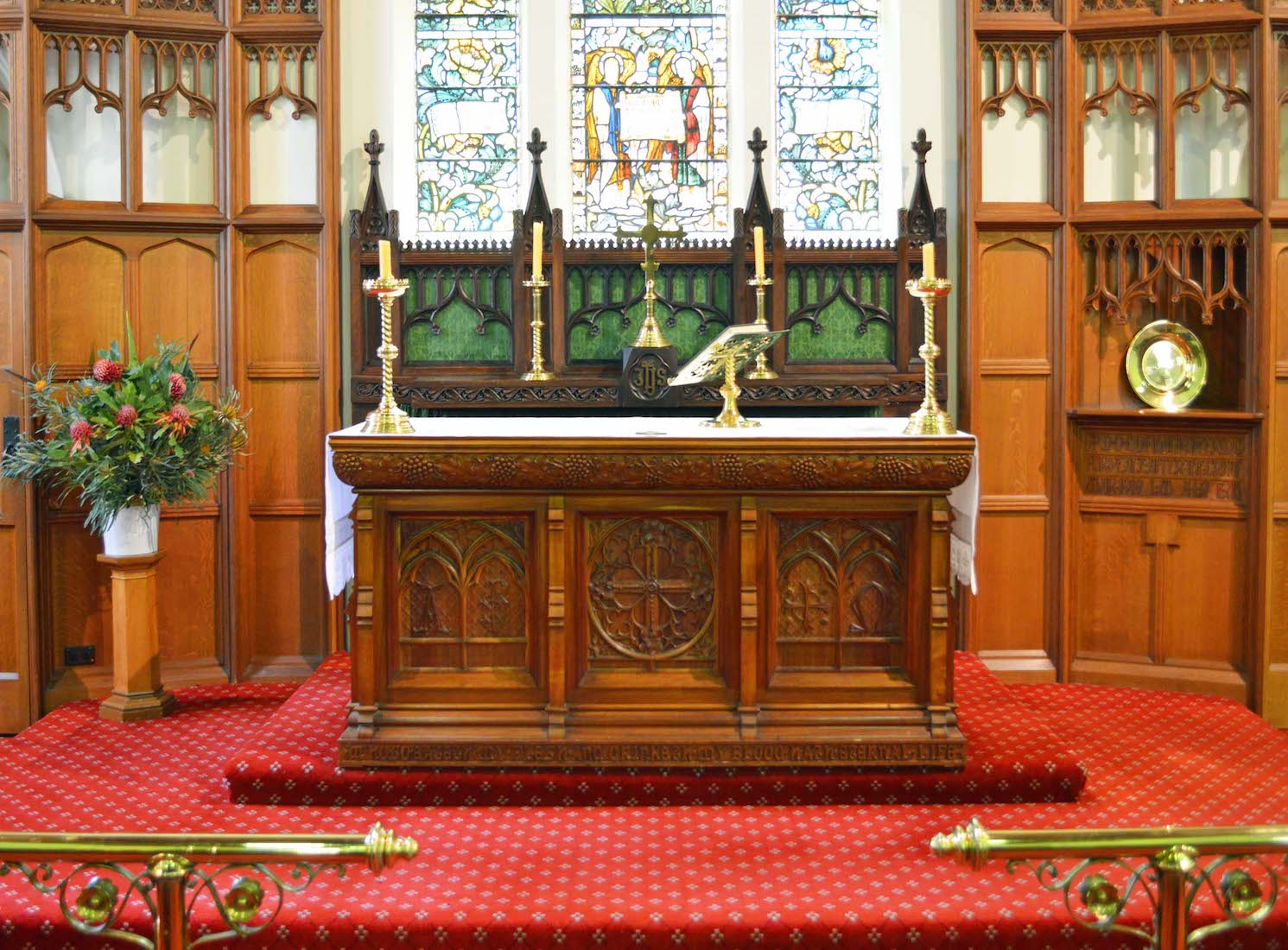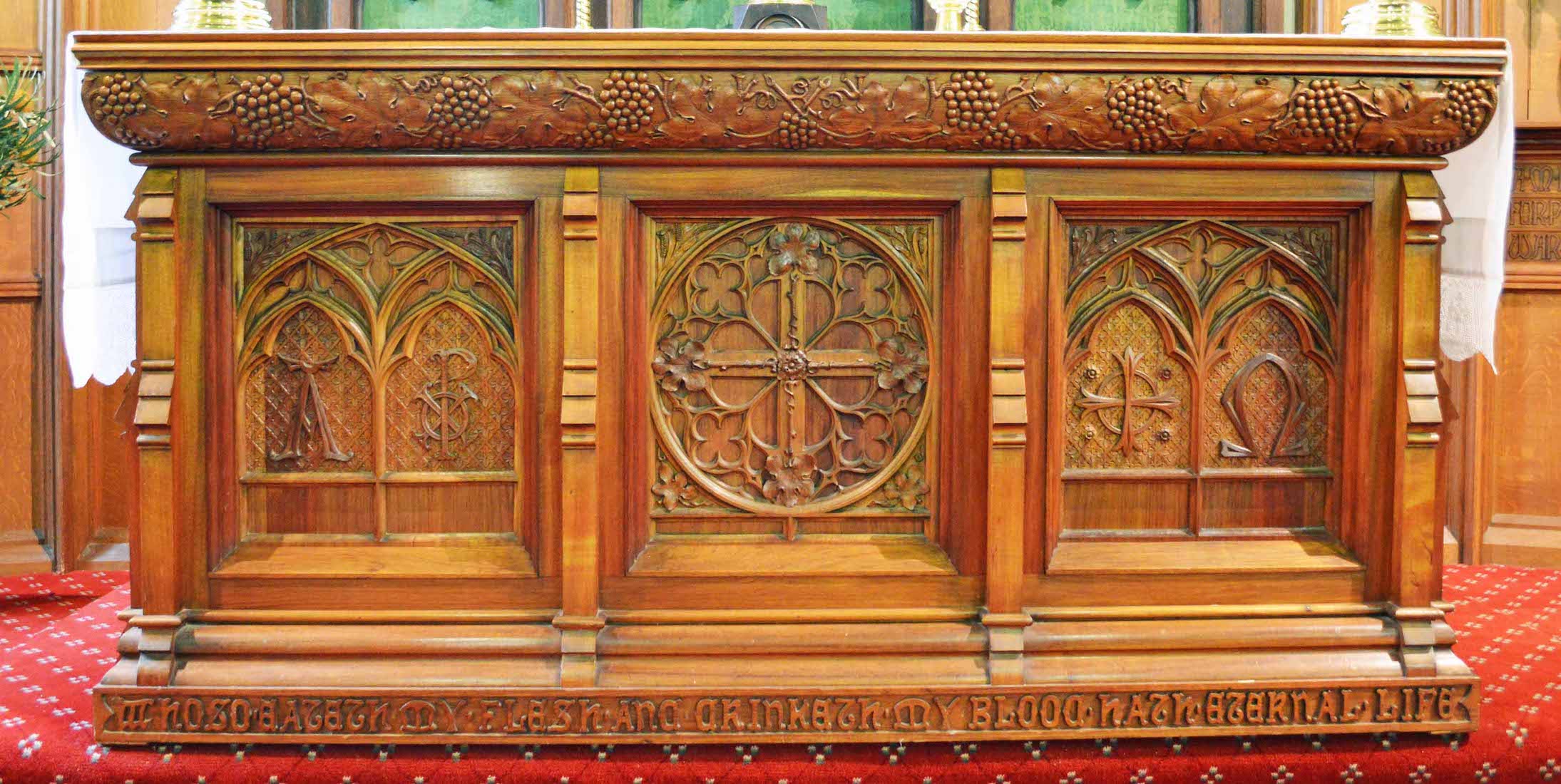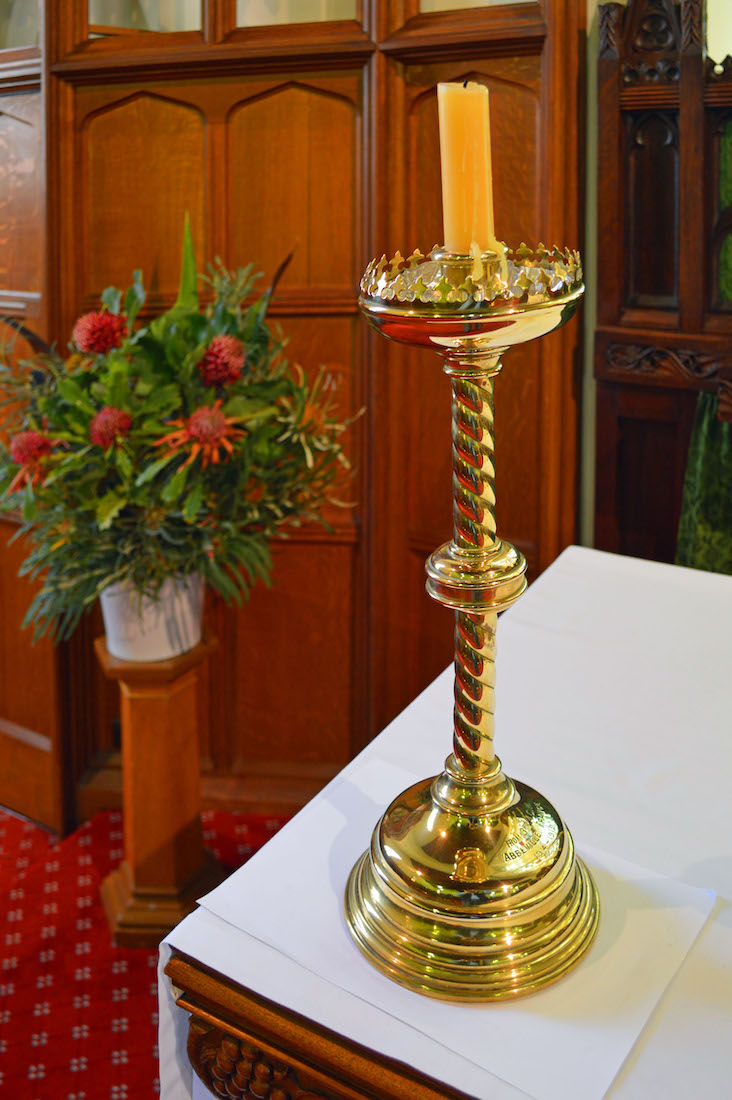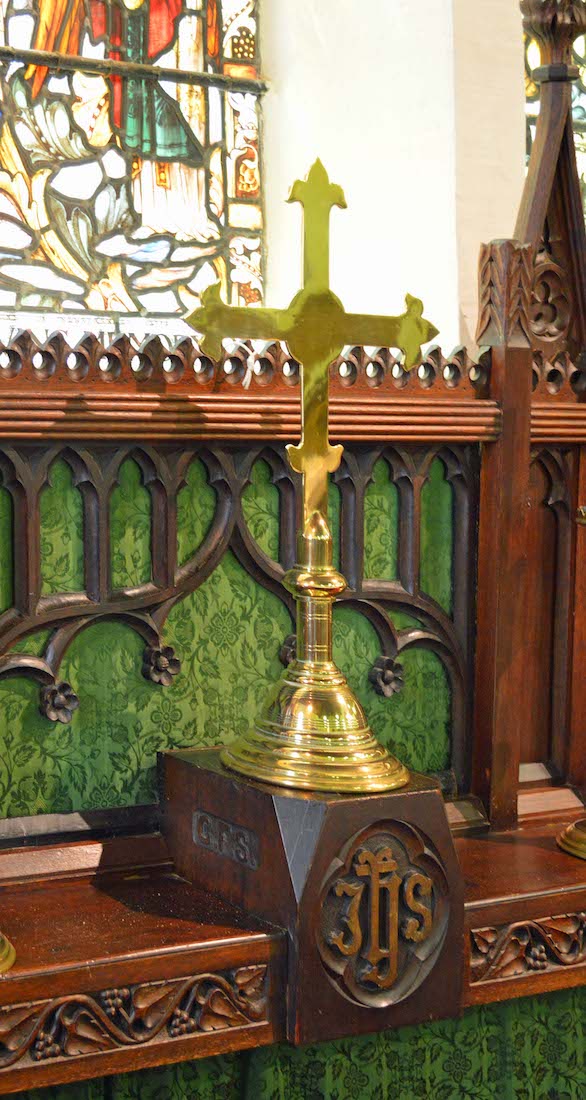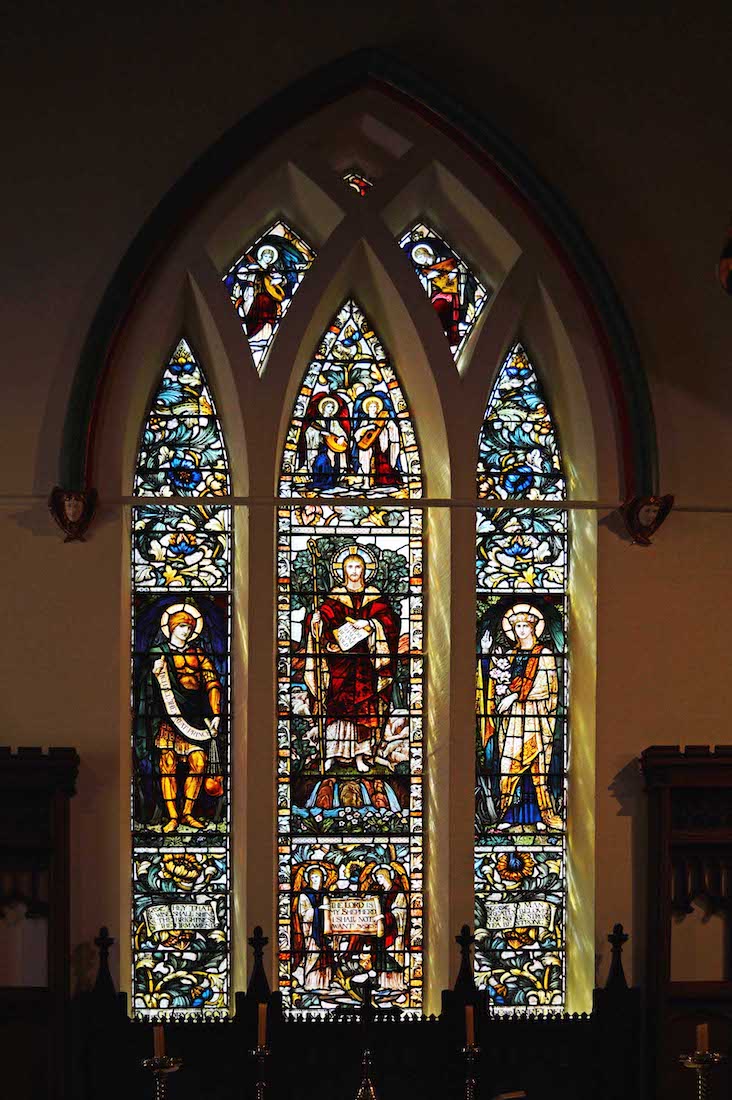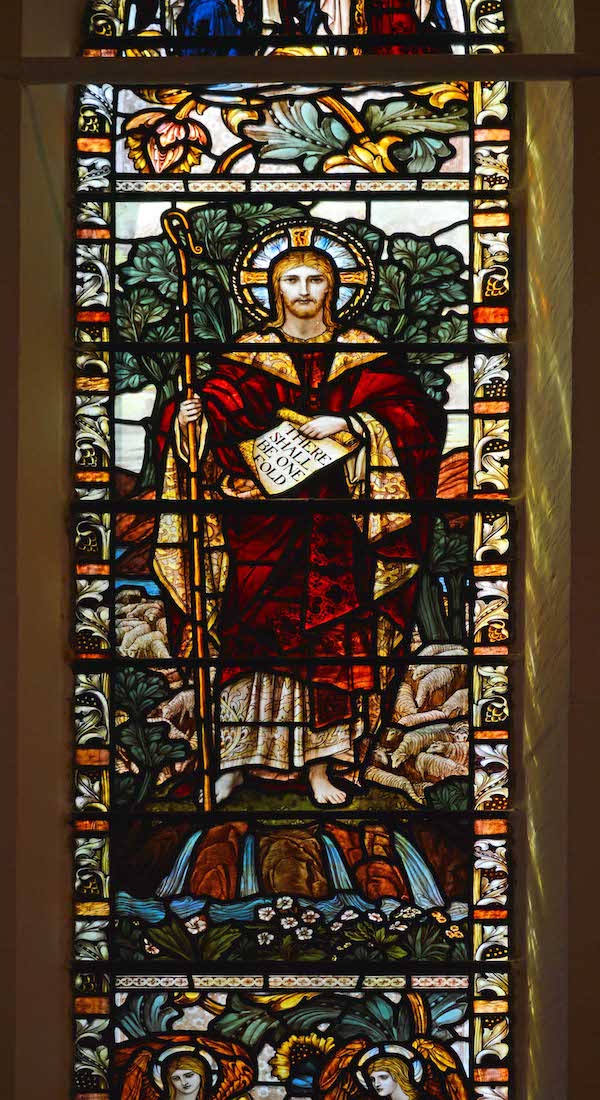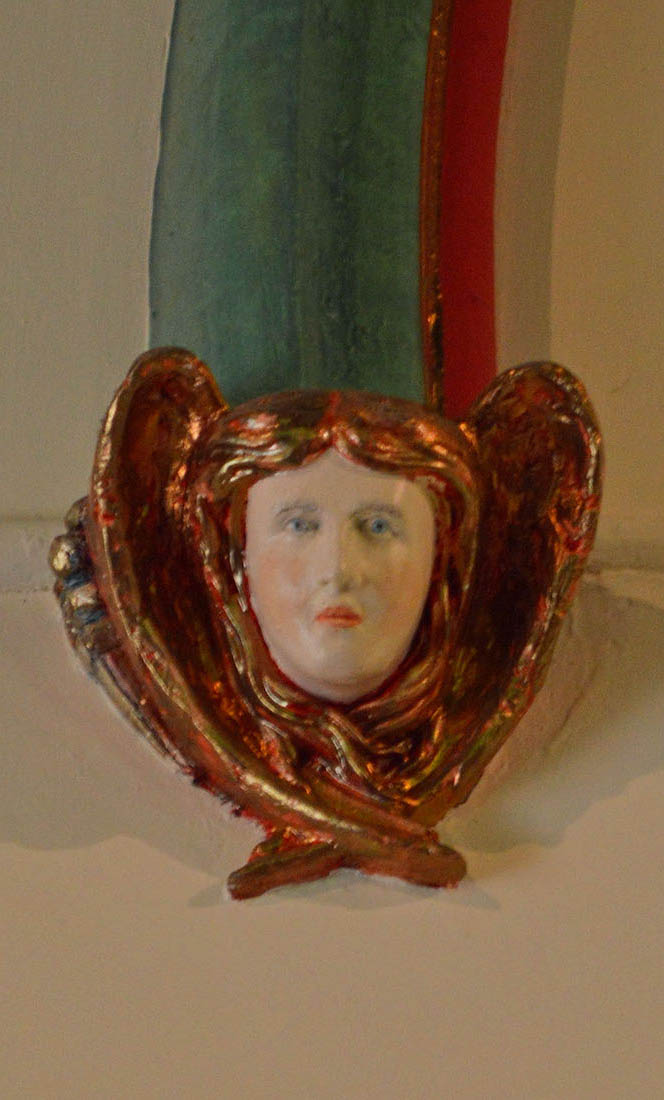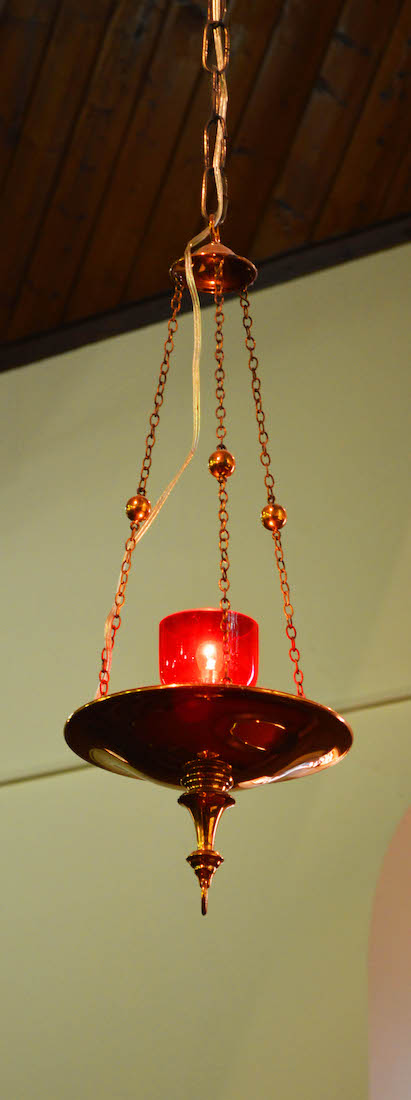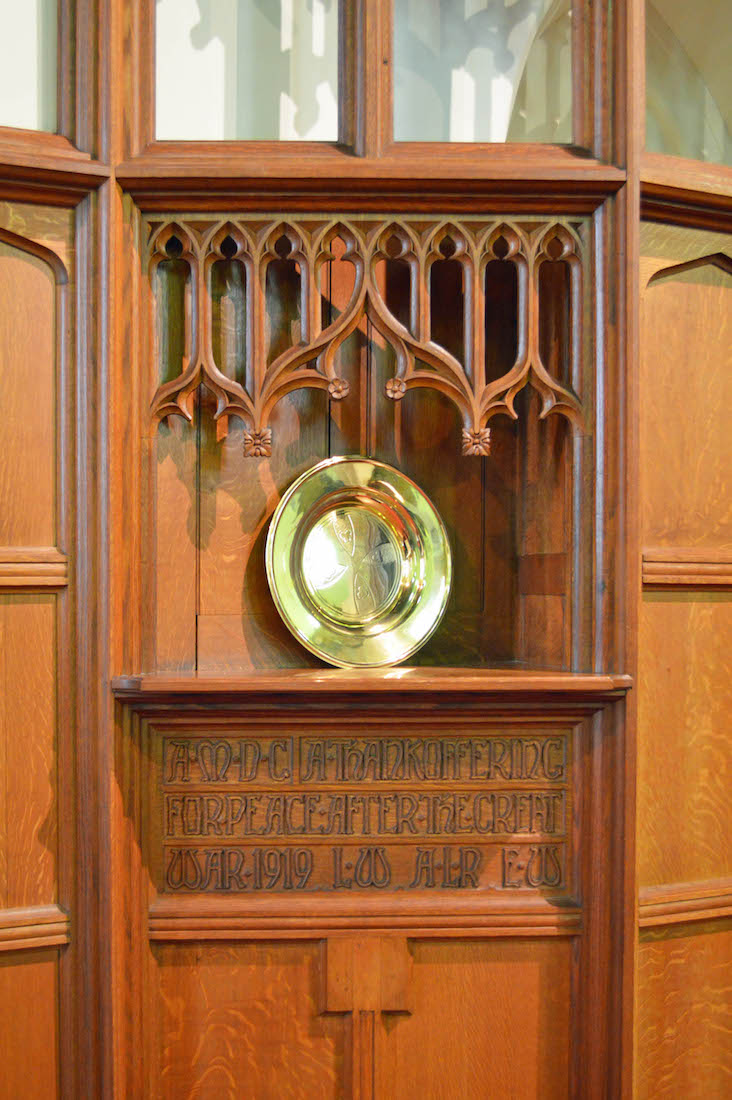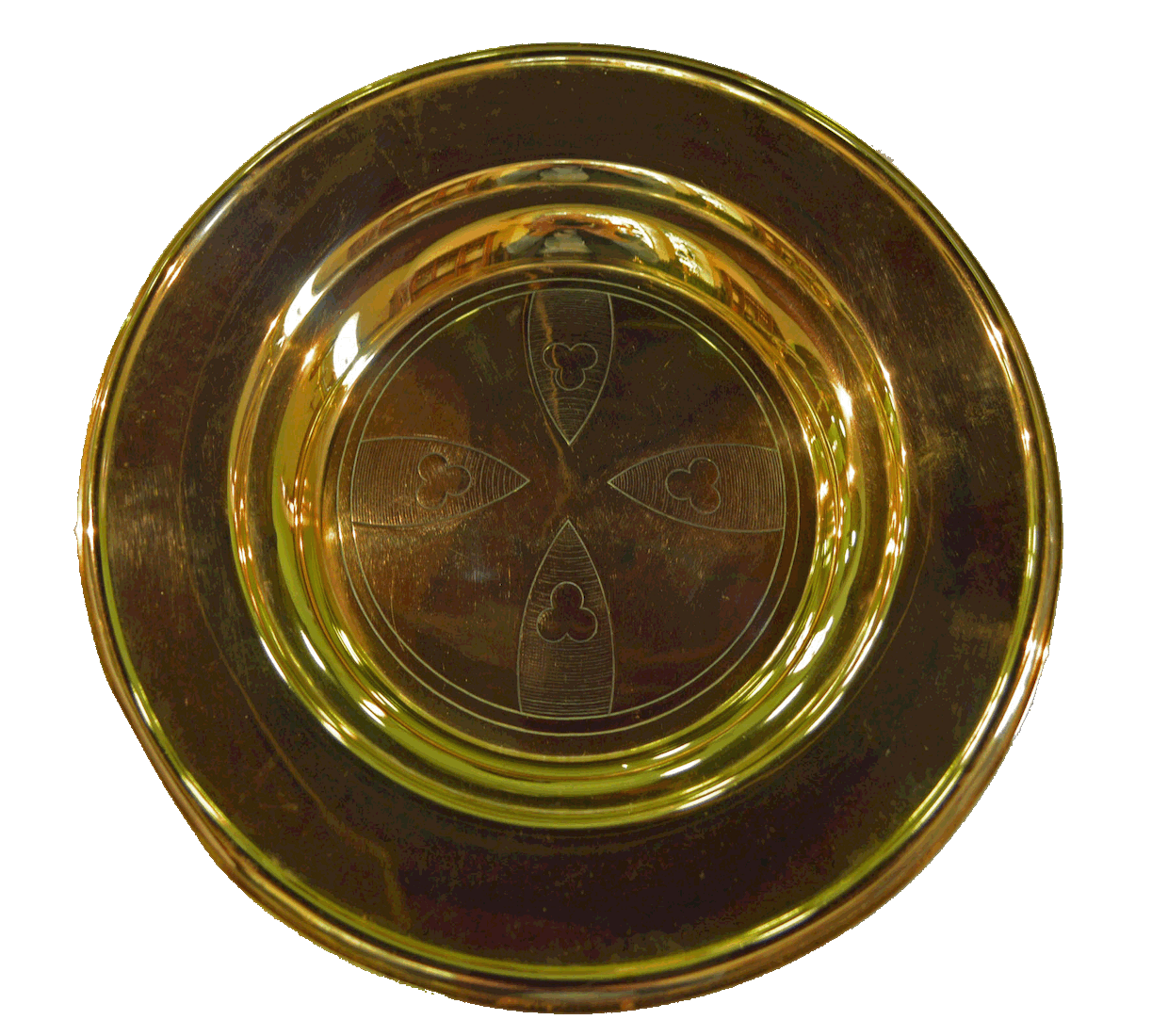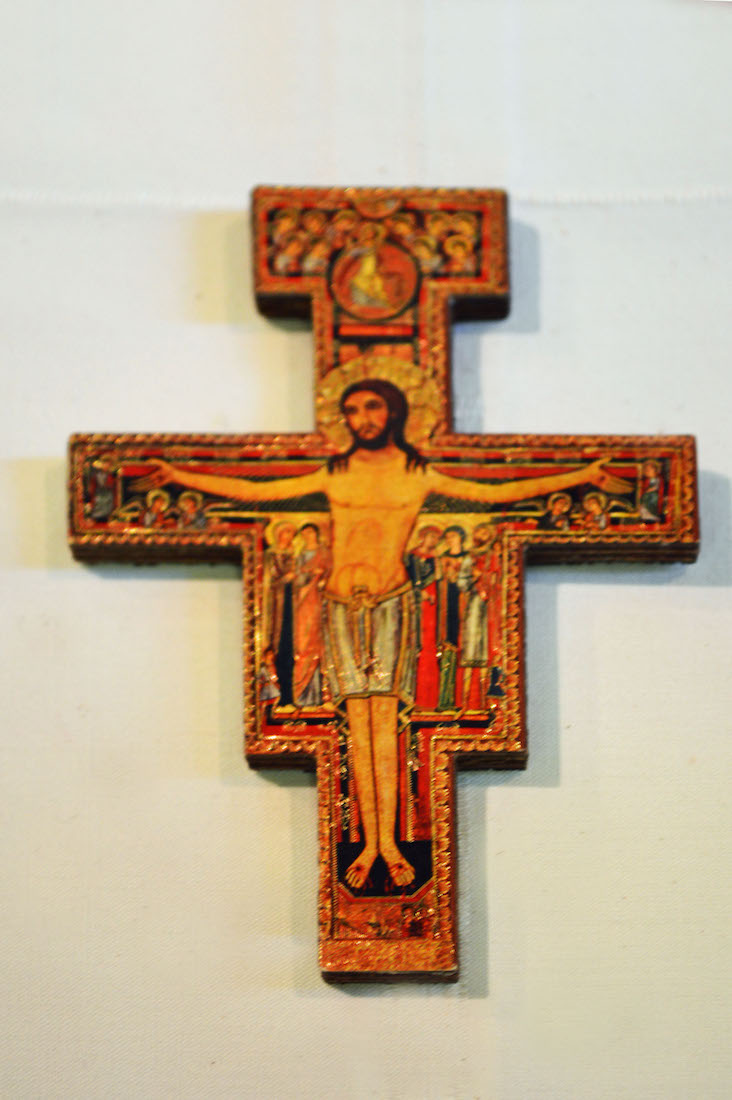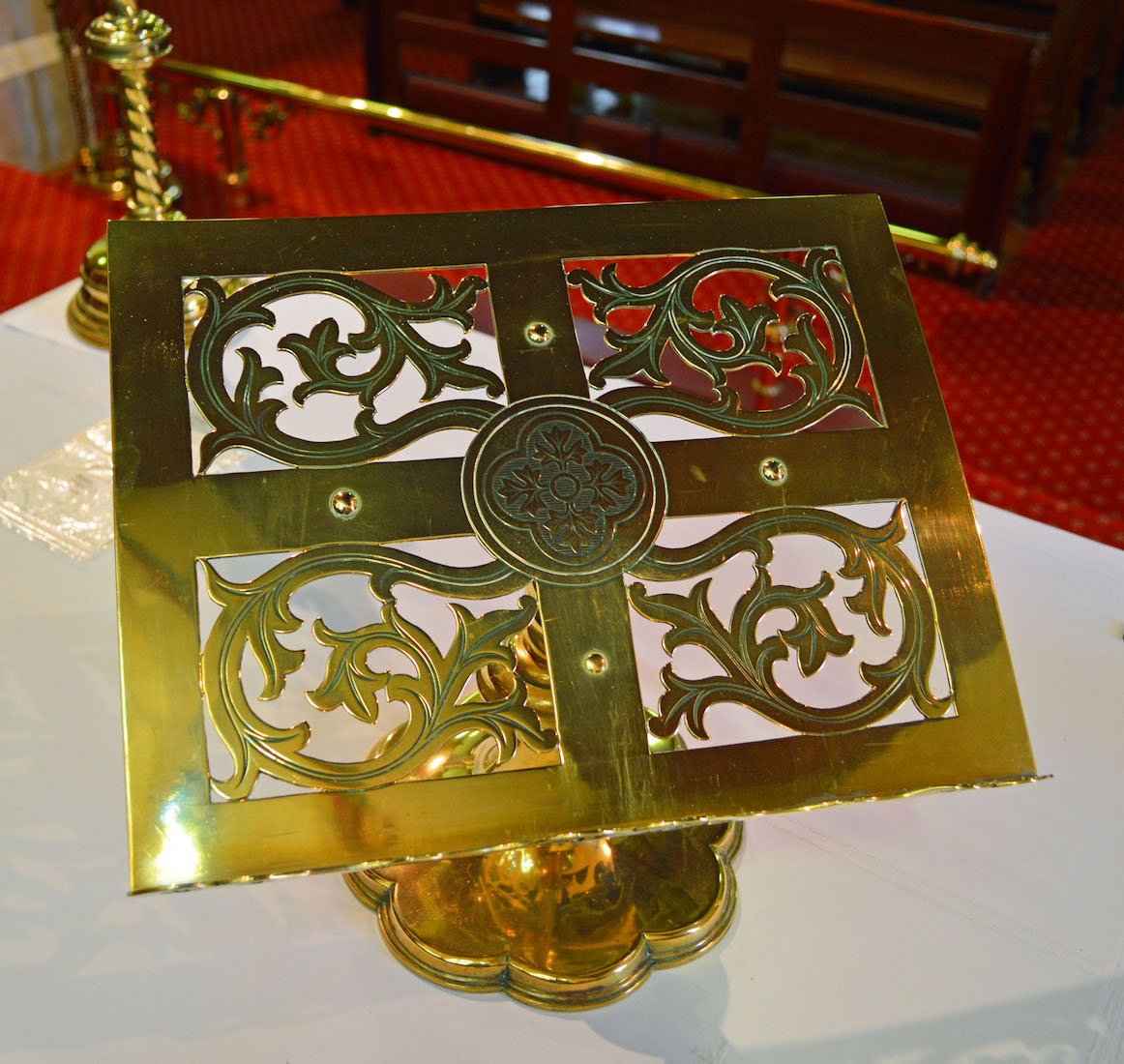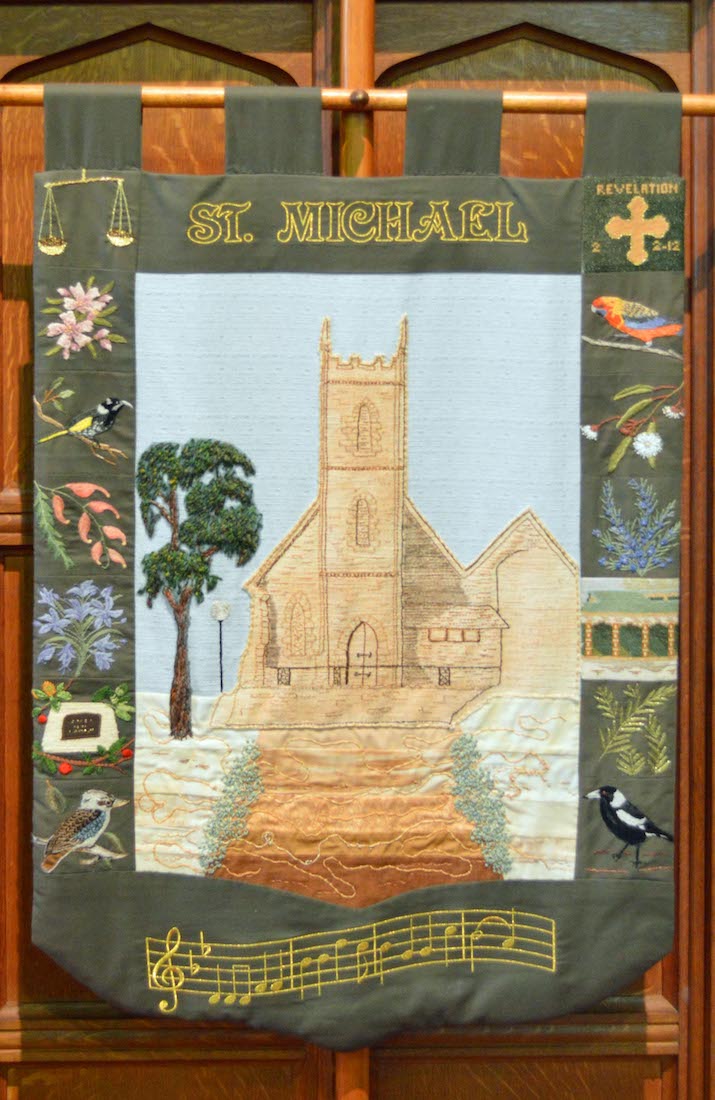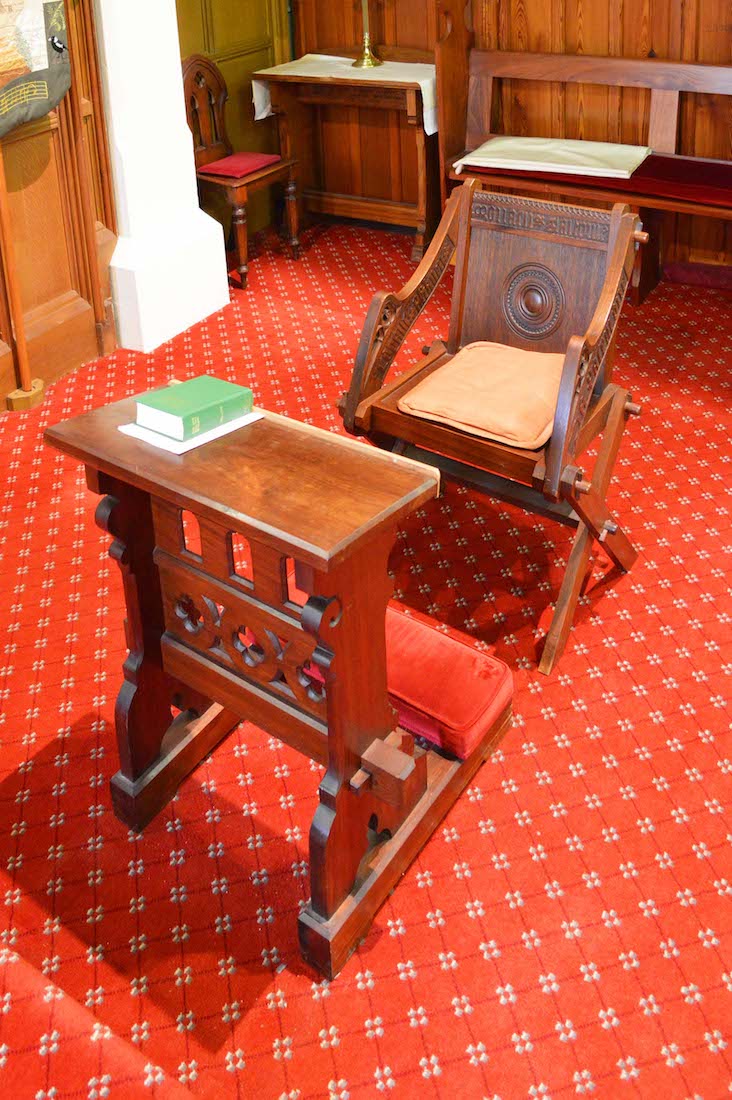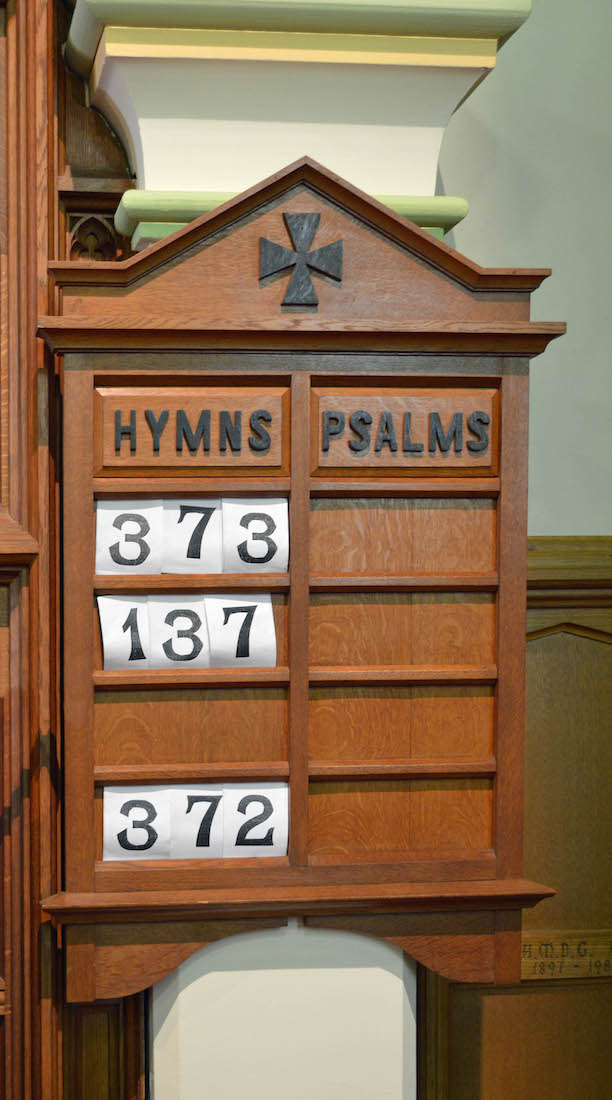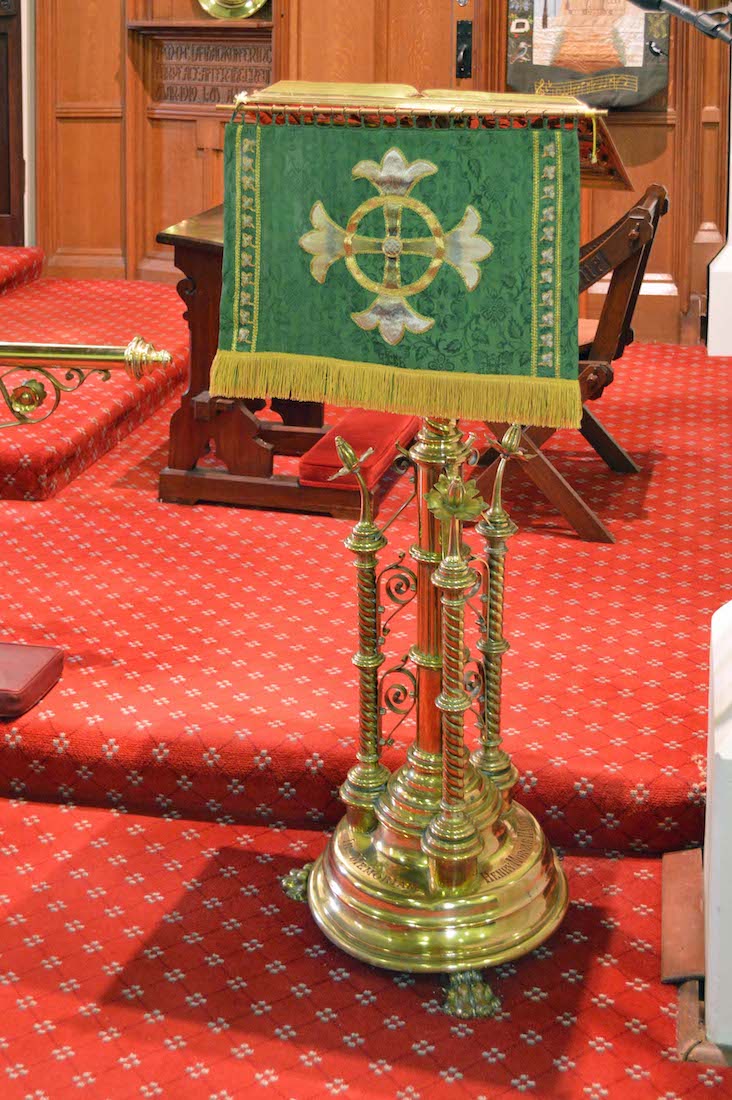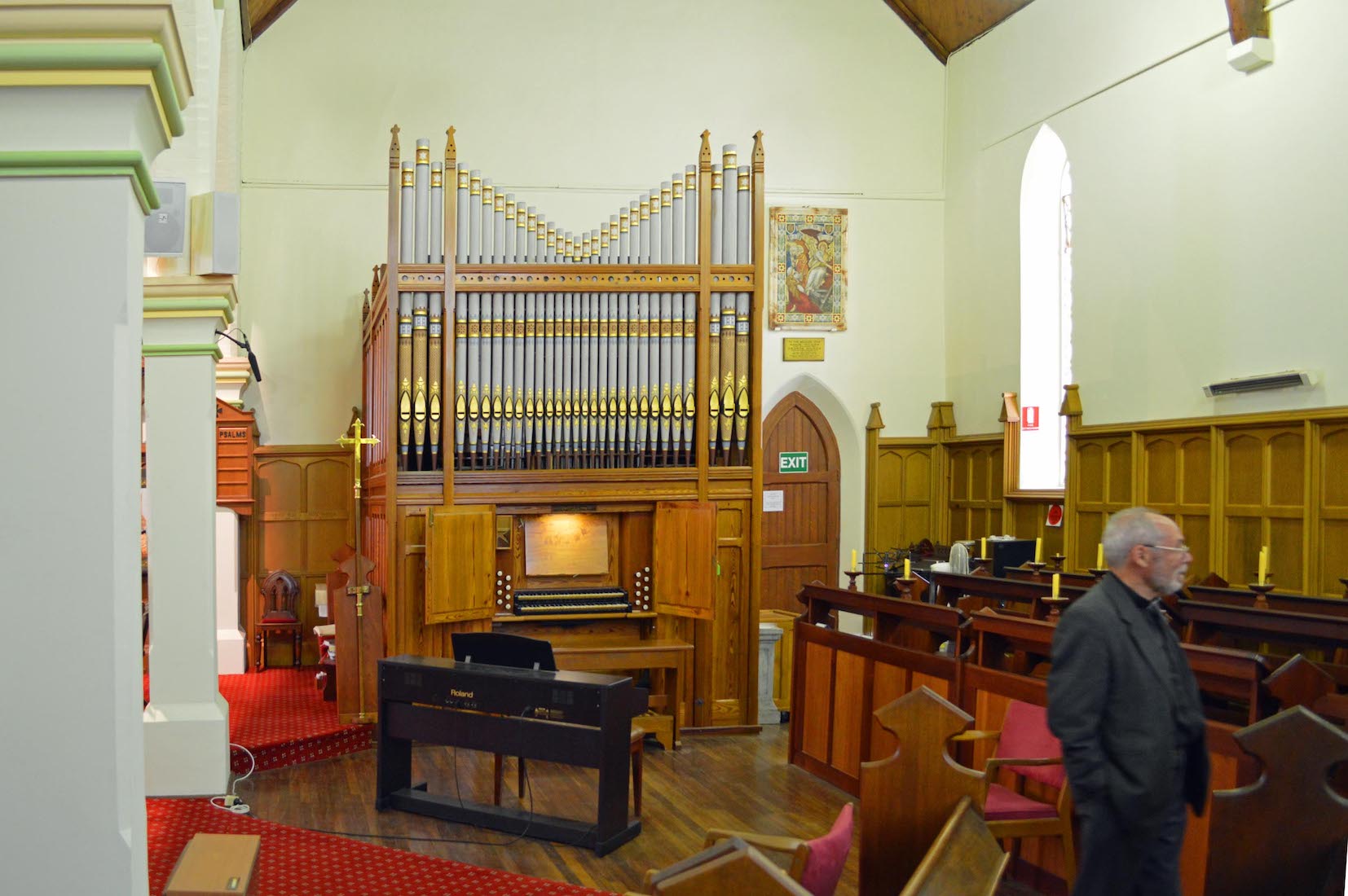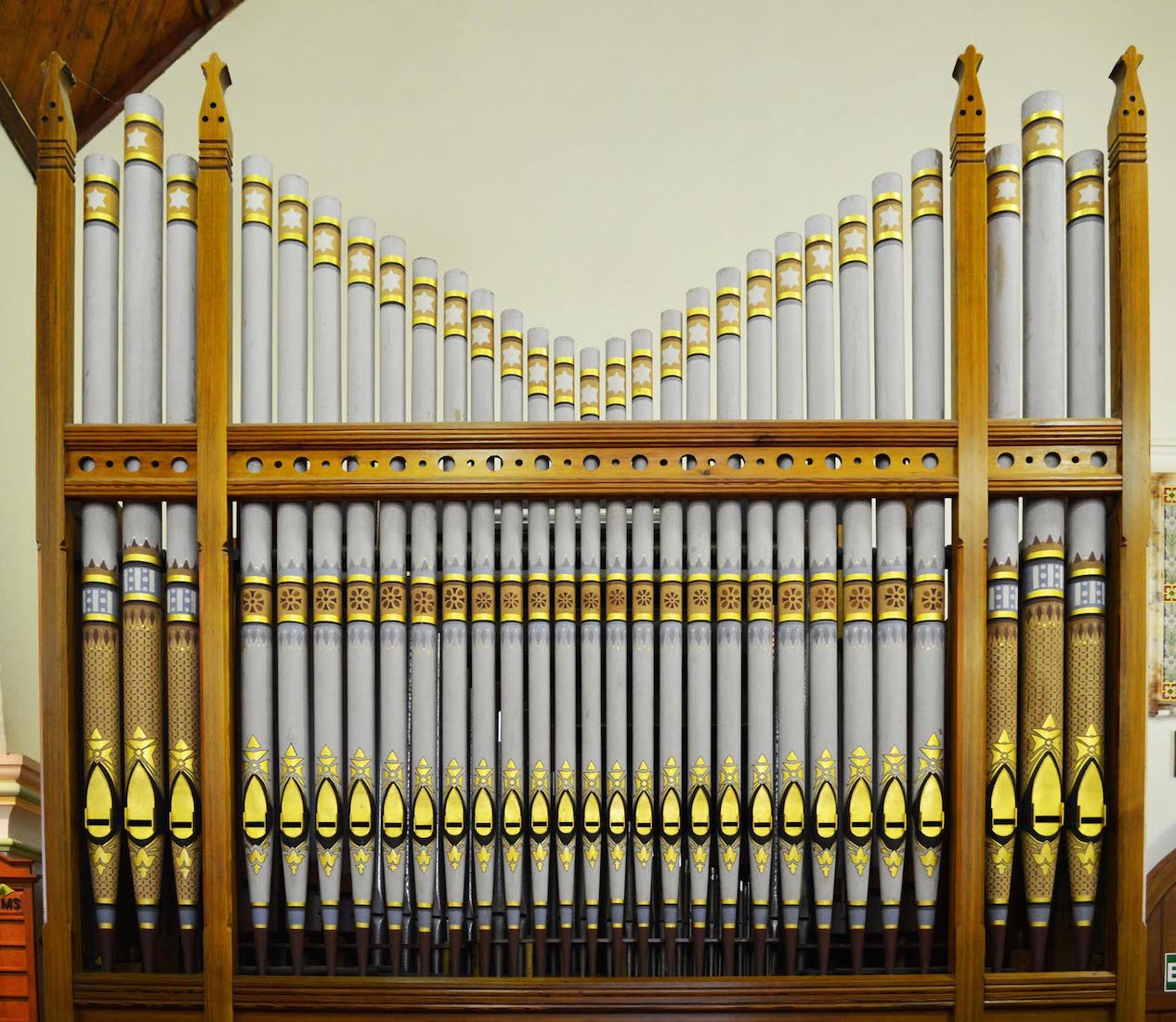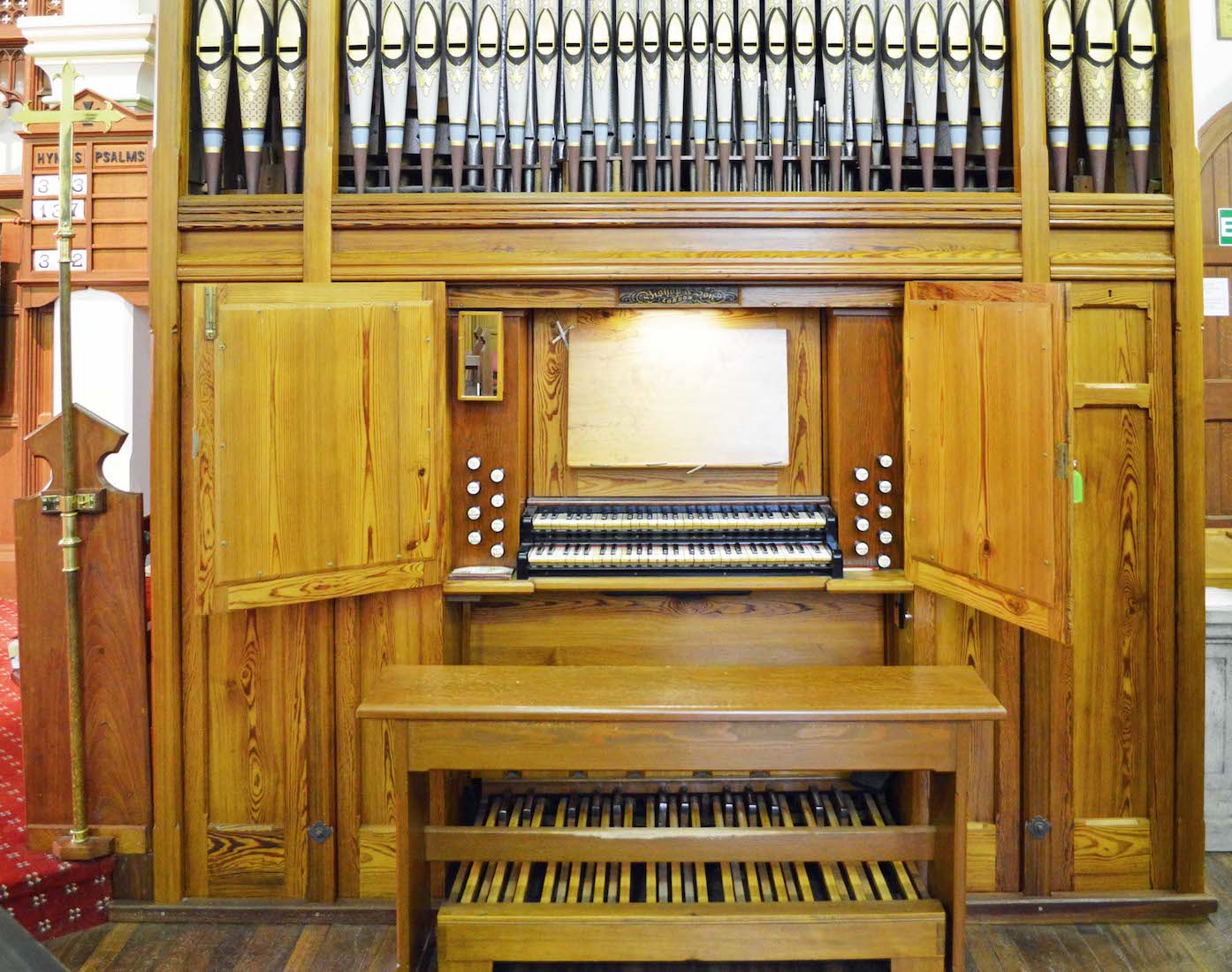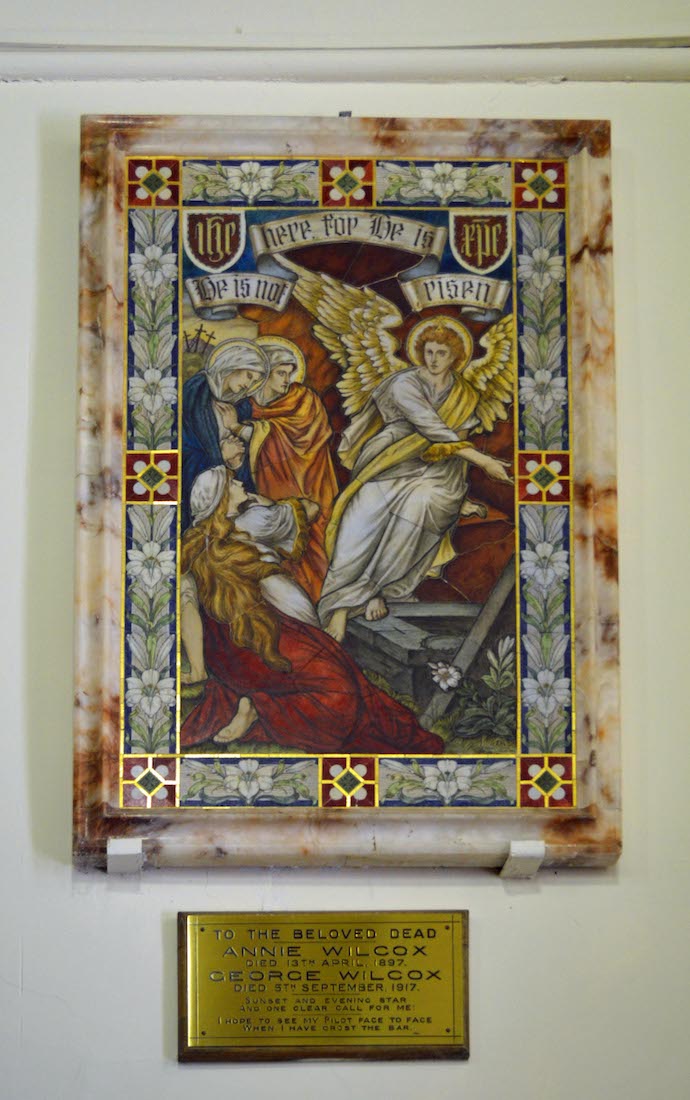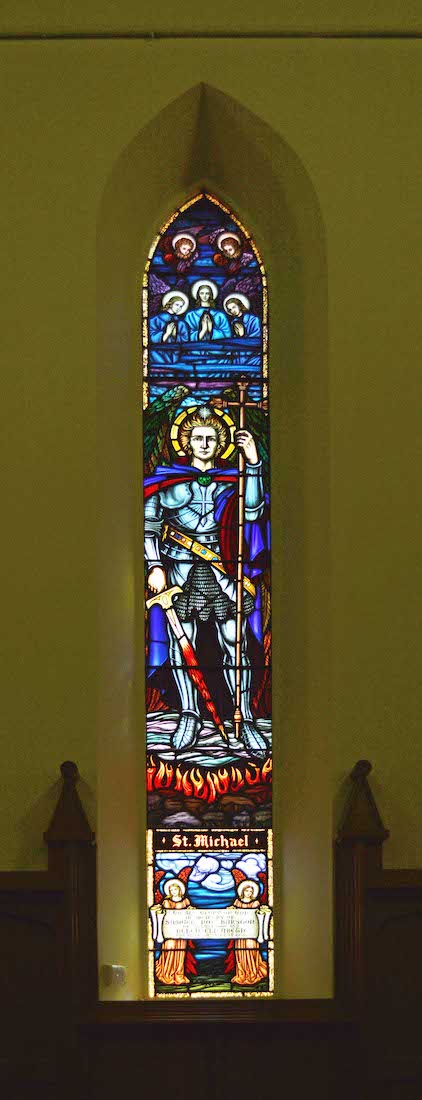

The second window on the North wall is the St Michael window. This window was made by Brooks Robinson Ltd in 1961. It shows St Michael carrying a cross and a very bloodied sword! The inscription reads: To the glory of God In memory of Samuel Roy Burston 20th August 1960 and Helen Elizabeth his wife 18th August 1958’. INDEX
22. PULPIT CORNER
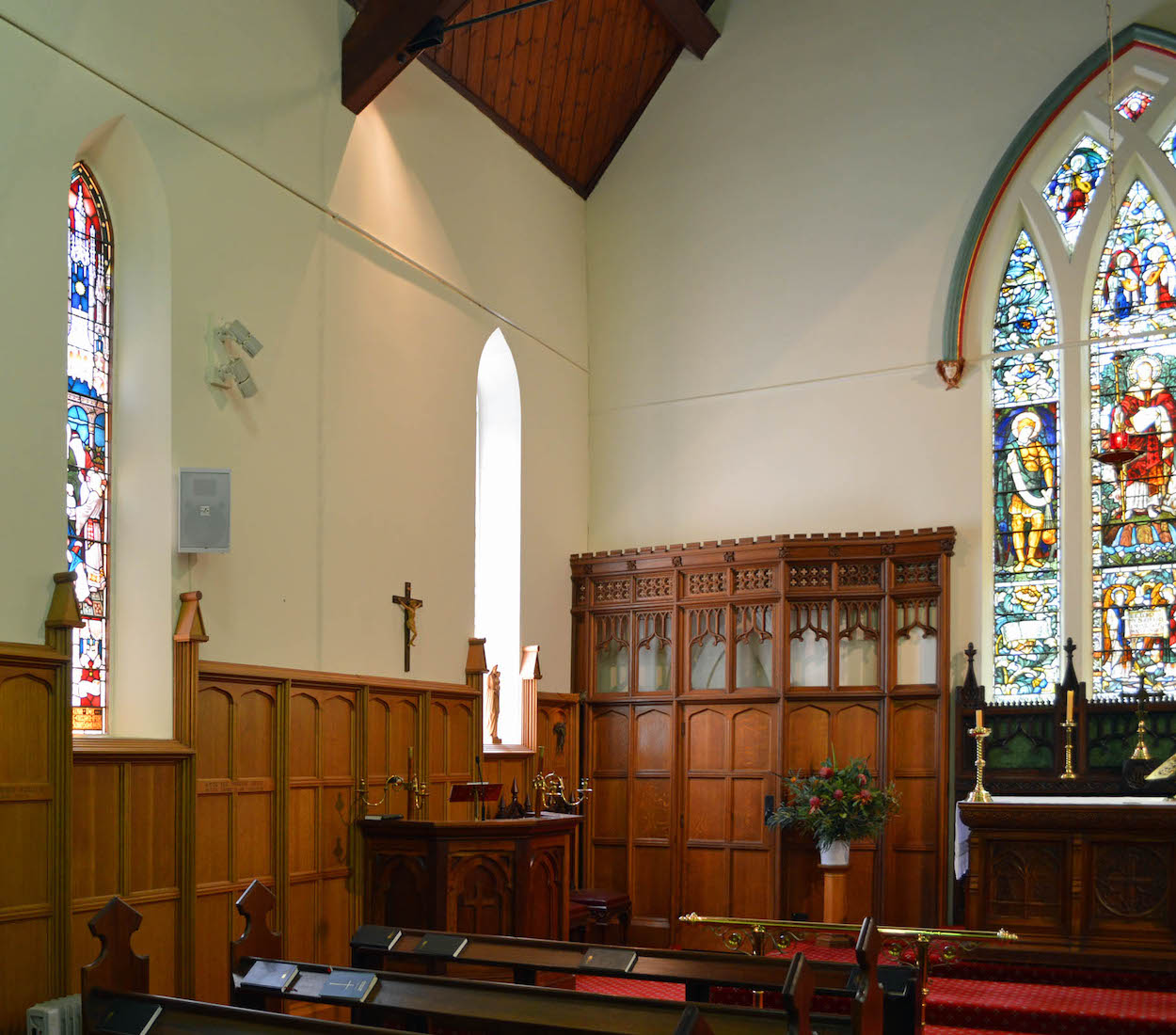
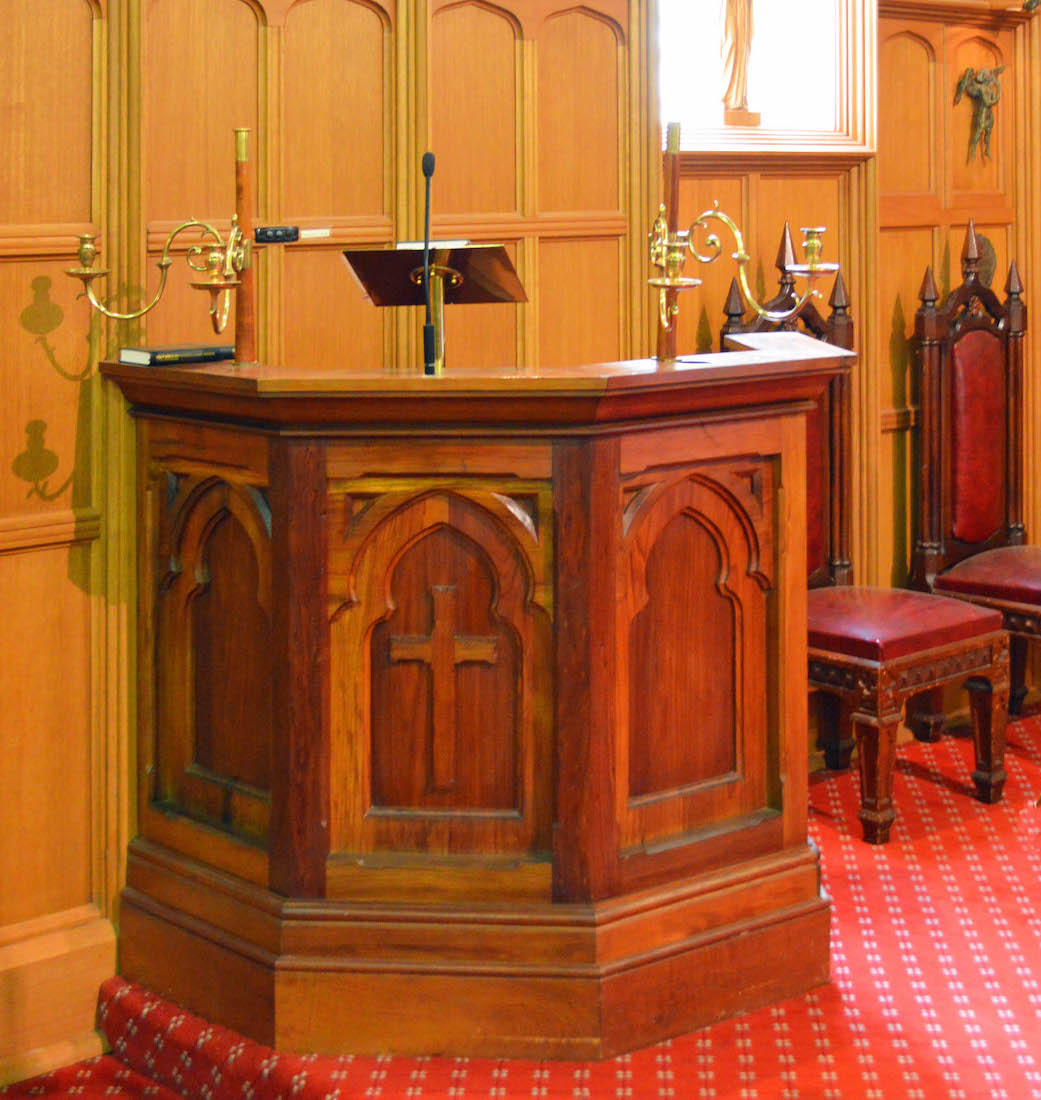
We now come to the North Eastern corner where the pulpit stands. The pulpit was purchased with money raised as part of the Diamond Jubilee Celebrations and dedicated on 5th May 1912. Originally on a high platform, it was lowered to its present height when the sanctuary area was altered in 1952. The window behind the pulpit contains a diagonal lattice of plain glass, but there is another stained glass window just at the left of this photo.
23. CHILDREN’S WINDOW
The Children’s Window shows Christ as a boy in the Temple. It was made by Montgomery and Grimbly in 1908, and paid for by the children of the Sunday School. Below the scene is a scroll which reads. ‘They found Him in the Temple’. Below this is the inscription: ‘Ad Glorium Dei Erected by the Children of the Congregation and Sunday School October 1900’. In very small print below this we read: ‘Montgomery and Grimbly Adelaide and Melbourne’.
24. CRUCIFIX AND MADONNA
The eastern-most nave windows on either side are a diagonal lattice with translucent glass. The window alcove on the North wall contains this beautifully carved wooden Madonna. A Madonna is a representation of Mary, either alone or with her child Jesus. These images are central icons for both the Catholic and Orthodox churches. The word is from Old Italian ma donna (my lady). The origin of this Madonna, and of the nearby crucifix, seem to be unrecorded.
25. SCULPTURES
The aumbry, where the blessed elements of the Eucharist are kept, is in the North Eastern corner of the church. There are two small bronze sculptures and a sculpted bronze plaque. An angel head adorns the light fixture, and a sculpture of St Michael is attached to the aumbry door. Both were created by noted South Australian artist John Dowie. The plaque reads: ‘To the glory of God In memory of Sheila Gwendoline Thomas 1918 – 1978 and Harold Davey Thomas 1918 – 1989 Faithful Christians and beloved parents’.
26. ALTAR RAILS
When installed in 1899 the brass altar rails originally enclosed the altar on three sides. In 1952 the sanctuary area was extended by six feet (1.8 metres) into the nave, and the elegant rails resited to their present position.
27. SANCTUARY VIEW
The sanctuary is a pleasant area. We have already noted the key features, but now observe the detailing: along the top of the panelling, the reredos, the altar, the altar rails, the woodwork above the alms plate, and even along the top of the organ. Note too the angel faces at the ends of the arch above the window. There is space behind the altar for the priest to stand comfortably.
28. SANCTUARY
This is a similar view from a position directly in front of the altar. Immediately behind the altar is the reredos, and its shelf (retable or gradine). The reredos was dedicated on Christmas Day in 1904. It is carved from Singapore Cedar, and features tracery panels ‘in the arcade style’. These are repeated in the beautifully carved screens of English oak on either side of the reredos. They were a Thank Offering for Peace after the Great War 1919 by the Misses Lily and Eva Watt and Adelaide Rymill.
29. ALTAR
The altar was presented by Mrs Joseph Fisher for the Diamond Jubilee in 1912. Carved from English oak, the design incorporates traditional Eucharistic symbols of vine leaves, grapes and wheat. At the base is carved: ‘Whoso eateth my flesh and drinketh my blood hath eternal life’. The front panels feature various Christian symbols, including the Alpha and Omega, and the Chi-Pho. A cross is at the centre.
30. CANDLESTICK AND CROSS
The large brass candlesticks on the altar were used in World War I in the 3rd Australian general Hospital in Abbeville, France. The brass cross has an interesting base. The front panel carries the letters IHS – a well known abbreviation of the name ‘Christ’ – in fact a Latinized form of the first three letters of the word in Greek. On the side are engraved the letters G. F. S. – likely a reference to the Girls’ Friendly Society.
31. EAST WINDOW
The 1901 East window was designed by John William Brown of Newcastle-on-Tyne. The central panel shows the Risen Christ as Shepherd, with a scroll: ’There shall be one fold’. The figure at left carries a scroll reading ‘Michael the great prince’. Below the figures are three scrolls: ‘They that be wise shall shine as the brightness of the firmament. The Lord is my Shepherd, I shall not want. O man greatly beloved, fear not, be strong, yea, be strong.’ At the base of the window is the inscription ‘To the glory of God and in loving memory of George and Jane Elder’. .At right is one of the angel faces decorating the ends of the arch above the window.
32. ALMS PLATE AND SANCTUARY LAMP
Christian churches often have at least one lamp continually burning before the tabernacle, not only as an ornament of the altar, but for the purpose of worship to indicate and honour the presence of Christ. This is the sanctuary lamp – often red, as here, to be distinctive. To the right of the altar stands a brass alms plate. Under where the alms plate sits are the words alluded to earlier: AMDG Thank Offering for Peace after the Great War 1919 L.W A.L.R E.W.
33. CROSS AND STAND
Alongside the large brass candlesticks on the altar we find this ornate brass reading stand, and a small Franciscan or San Damiano cross. The original San Damiano Cross is the large Romanesque rood cross that St. Francis of Assisi was praying before when he received the commission from the Lord to rebuild the Church. It hangs in the Basilica of Saint Clare in Assisi, Italy. Franciscans cherish this cross as the symbol of their mission from God. The cross is sometimes called an icon cross because it contains images of other saints and people related to the incident of Christ's crucifixion.
34. BANNER AND PRAYER DESK
On the Eastern wall to the right of the altar hangs a banner depicting St Michael’s church in an Australian bush setting. Below is the music of the hymn: Come, let us join our cheerful songs With angels round the throne. Nearby is this prayer desk and Glastonbury chair. The origins of the prayer desk are unknown. The Glastonbury chair, made in Adelaide by John Cain in 1903, is a copy of one carved by a 16th century monk, John Arthur, of Glastonbury Abbey in Somerset.
35. HYMN BOARD AND RETABLE
A hymn board hangs on the wall next to the tapestry. The featured cross is interesting. It is a variant of the ‘cross pattee’. Around 1901, a famous puzzlist by the name of Dudeney published a seven-piece dissection of what he termed a ‘Maltese cross’ (but which is actually this variant of the cross pattée) into a square. The credence table to the right of the altar was given by Mrs. Mollie Bowen in memory of her parents ‘A. W. Clampett M.A. Rector of this Church, and Alice his wife’. The credence table was dedicated in 1954.
36. LECTERN
At the right of the altar rails stands this handsome brass lectern made in England by J. Wippell & Co. It was dedicated on Easter Day 1901. It was a gift from the congregation in memory of Henry Morgan Hawkes who served as a Warden over a long period. The inscription reads ‘In memoriam Henry Morgan Hawkes Obit. Aug. 6 MDCCCC’.
37. SOUTH NAVE, EAST VIEW
We now move across into the South nave. Looking Eastwards we notice how the two naves link together, with the sanctuary platform visible at left. In this nave we find the organ and choir stalls. A marble mosaic hangs on the wall to the right of the organ. The adjacent window has clear glass.
38. ORGAN PIPES
The organ was purchased in January 1878 from the famous London firm of J C Bishop & Son. It was one of three similar organs imported at the time. The others were for St Peter’s Cathedral (now, much altered at St Augustine’s in Unley) and St Peter’s College Chapel. In 1913 an hydraulic pumping mechanism was installed, and in 1945 the organ was converted to electricity.
39. ORGAN CONSOLE
The processional cross at left was first used in 1918. The cross is a fleur de lis cross, with lily petals embellishing the ends of each arm. The lily symbolizes innocence and purity, as well as referencing the Virgin Mary. The history of the organ begins in 1877, when Mrs. Read, the Incumbent's wife, who was on holiday in England at the time, took the necessary steps to secure a suitable organ. The organ was delivered in Port Adelaide for the sum of £500, and installed by Mr. McKenzie in 1878, for £25. It was originally situated on the Southern wall where it was powered by water (to the detriment of the foundations).
40. TABLET
This beautiful marble mosaic tablet set in an alabaster frame is on the East wall of the South nave. It shows the angel at the opened tomb of Jesus, and carries the words: ‘He is not here but is risen’. The plaque reads: ‘To the beloved dead Annie Wilcox Died 13th April 1897 George Wilcox Died 5th September 1917 Sunset and evening star and one clear call for me! I hope to see my Pilot face to face when I have crost the bar.’ Made in England, it was unveiled on Easter Day 1922.


